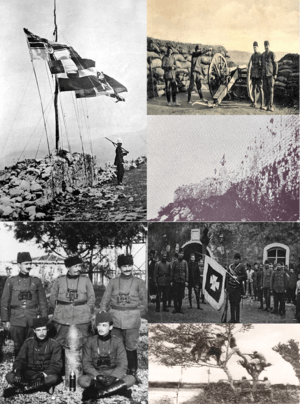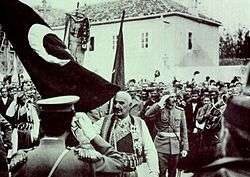Siege of Scutari (1912–13)
| Siege of Scutari | |||||||
|---|---|---|---|---|---|---|---|
| Part of the First Balkan War | |||||||
 Clockwise from top left: Flags of Great Powers on Shkodër fortress; Ottoman troops defending Shkodër; Montenegrin flag flying over the Shkoder fortress; Captured flag standard of Montenegrin forces proudly displayed by Turkish and Albanian troops; Albanian guerillas shooting from a tree; Albanian officers posing with captured Montenegrin ammunition | |||||||
| |||||||
| Belligerents | |||||||
|
|
| ||||||
| Commanders and leaders | |||||||
|
|
| ||||||
| Strength | |||||||
| 20,000[5] | 40,000[5] | ||||||
| Casualties and losses | |||||||
| Unknown | ~ 15.000[5] | ||||||
The Siege of Scutari / Skadar took place from October 28, 1912 to April 23, 1913, with allied forces of Montenegro and Serbia against forces of the Ottoman Empire.
Naming
The Siege of Scutari is also referred to as the Siege of Shkodër[3] (Albanian: Rrethimi i Shkodrës, Serbian: Опсада Скадра), known in Turkish as İşkodra Müdafaası[6] or İşkodra Savunması.[7]
Background
In 1912, the Balkan League—consisting of Serbia, Montenegro, Greece and Bulgaria—had jointly declared war against the Ottoman Empire. Montenegro mobilized its troops and prepared to attack the Ottoman forces in Albania directly to the south. However, behind stood the intention to expand Montenegro at the expense of territories with an overwhelming Albanian majority. Montenegro considered itself successor of Zeta, a medieval Serb polity that played an important part in the overall development of Serbian Empire, with Skhoder as its capital. With the transition of power from the last feudal lords Balšići to Venetians, and eventually Ottomans, who established a city as an administrative center of the region, the "lost capital" became a symbol of oppression for the Montenegrins.[8] Historically, the border between the medieval Zeta and Albanian principalities was the Drin river, as pointed out by 17th century Montenegrin ruler and historiographer Vasilije and Montenegro sought to expand itself to its traditional borders. Furthermore, the region had considerable Slavic population. Many Montenegrins trace their heritage back to the region, which their ancestors abandoned after the Turkish occupation.[9]
Start of the war
On 8 October 1912 Gen. Hasan Riza Pasha announced that Montenegro had declared war on the Ottoman Empire in order to get rid of the 600 years of oppression by the "Turkish foot", as the enemy claimed, and that its troops were crossing the border between Montenegro and Albania. Two hours after the news the Montenegrin troops, as expected, were approaching Scutari. Up to 70% of the Turkish army in the inner parts of the Balkans was composed of Muslim Albanian conscripts during the freedom struggle from the Ottoman Empire. At noon Hasan Riza Pasha in his headquarters gathered all his commanders and told them:
The city will soon be surrounded, but this city will not fall into the hands of Montenegrins. Shkodra is our fate or our grave, but not our shame. Today we have five thousand troops, but over 20 thousand others are coming to our assistance. As of today begins an uphill battle, that none of us knows how long it will last
Battle
The siege started on October 28, 1912. The attack was originally carried out by the Montenegrin army under the command of Prince Danilo. However, his forces encountered stiff resistance, and the Serb army sent reinforcements to help its Montenegrin allies.
Radomir Vešović participated in the siege where he was wounded twice,[11] showing an exemptional courage which earned him a golden Obilić Medal and nickname the knight of Brdanjolt (Serbian: витез од Брдањолта).[12]
The combined Turkish and Albanian defenders led by Hasan Riza Pasha and his lieutenant, Esad Pasha Toptani, resisted for seven months and managed to inflict a heavy toll on the besiegers.[13]
Death of Hasan Riza Pasha
On January 30, 1913, Riza Pasha was ambushed and killed by Osman Bali and Mehmet Kavaja,[3] two Albanian servants of Esad Pasha, as he left Esad's house after dining with him.[10] Riza Pasha wanted to keep up the defense of the besieged city but Esad Pasha wanted to continue his secret negotiations with Montenegro, which were done through the counsel of Russia in Scutari. Esad Pasha's plan was to hand over Scutari to the Serbs and Montenegrins as the price for their support in his attempt to proclaim himself King of Albania.[10][14] On 6 February King Nikola received delegation of chieftains from Malësia who stated that they recognize him as their suzerain and requested to join 3000 of their fighters with Montenegrin forces to capture Scutari. On 7 February they were ordered to attack in the direction Jubani—Daut-agha's kulla.[15]
Surrender

On April 21, 1913, Esad Pasha made the official proposal to surrender the city to Montenegrin Gen. Vukotic. On April 23 his proposal was accepted and he was allowed to leave the city with full military honors and with all of his troops and equipment, except heavy guns. He also received a sum of £10,000 sterling from the Montenegrin King.[16] Essad Pasha signed the final surrender protocol[1] with the Montenegrins[17] Essad Pasha surrendered Scutari to Montenegro only after its destiny was decided by the Great Powers, after they forced Serbia to retreat and after it was obvious that the Great Powers would not allow Montenegro to keep Scutari. Essad Pasha was able to save many of his soldiers.[18] At the same time he managed to get the support of Serbia and Montenegro for the new Kingdom of Albania, which would gain Scutari indirectly by the Great Powers.[10]
Aftermath


The taking of Scutari removed the only obstacle to the Serbian advance in the remainder of Ottoman Albania. By November 1912 the country had declared independence but was yet to be recognized by anyone. The Serbian army eventually occupied most of northern and central Albania, stopping north of the town of Vlorë. It also managed to trap the remains of the Army of Vardar in what was left of Albania proper, but were not able to force them to surrender.[13] However, when the war was over, the Great Powers did not award the city to the Kingdom of Montenegro, which was compelled to evacuate it in May 1913, in accordance with the London Conference of Ambassadors. The army's withdrawal was hastened by a small naval flotilla of British and Italian gunboats that moved up the Bojana River and across the Adriatic coastline. International peace keeping force (Scutari detachment) from five countries - Austria-Hungary, Great Britain, France, Italy and Germany - was deployed in the city and kept until the start of WWI.[19] The Kingdom of Montenegro also later took Metohija, an area of Kosovo-Kosmet.
International reaction
.svg.png)
_crowned.svg.png)
.svg.png)
Cultural influences
Albanian novelist Ndoc Nikaj wrote an historical novel titled Shkodra e rrethueme ("Shkodra under siege") in 1913.[21] Bosnian Serb poet Aleksa Šantić wrote To Essad Pasha (Serbian: Esad Paši), inspired by the Siege of Scutari.[22]
See also
| Wikimedia Commons has media related to Siege of Scutari (1912–1913). |
Notes
- footnotes
- ↑ As the capital of the Ottoman Vilayet of Scutari this city was in the hands of the Turks until April 1913. Viscount James Bryce Bryce, Holland Thompson, Sir William Matthew Flinders Petrie, The Book of History: The Events of 1918. The Armistice and Peace Treaties, The Grolier society, 1921, p. 1125.
- citations
- 1 2 3 Erickson 2003, p. 312.
- ↑ Somel, Selçuk Akşin. Historical dictionary of the Ottoman Empire. Scarecrow Press Inc. 2003. lxvi.
- 1 2 3 Vickers 1999, p. 71.
- ↑ Erickson 2003, p. 237.
- 1 2 3 Въчков 2005, pp. 138-141.
- ↑ Abdurrahman Nafiz, Kiramettin, 1912–1913 Balkan Harbinde İşkodra Müdafaası, İstanbul Askerî Matbaa, 1933. (in Turkish)
- ↑ Genelkurmay Askeri Tarih ve Stratejik Etüt Başkanlığı, İşkodra Savunması ve Hasan Rıza Paşa, Kültür Bakanlığı Yayınları, 1987. (in Turkish)
- ↑ https://www.rastko.rs/rastko-al/zbornik1990/jbojovic-sloveni_l.php
- ↑ http://www.njegos.org/petrovics/istocg.htm
- 1 2 3 4 Ulli, Prenk (1995). Hasan Riza Pasha: Mbrojtës i Shkodrës në Luftën Ballkanike, 1912–1913. Shkodër, Albania: Albin. pp. 34–40. Retrieved 2011-06-13.
- ↑ Лесковац, Младен; Форишковић, Александар; Попов, Чедомир (2004). Српски биографски речник (in Serbian). Будућност. p. 176).
- ↑ (Čolaković & Čirgić 2008, p. 281)
- 1 2 Vlora, bej Eqerem. Lebenserinnerungen ("Memoirs"). Munich. 1968 and 1973.
- ↑ Pearson, Owen. Albania and King Zog: independence, republic and monarchy 1908–1939. I.B. Tauris. 2004. ISBN 1-84511-013-7 p. 38
- ↑ King Nikola--personality, work, and time. Crnogorska akademija nauka i umjetnosti. 1998. p. 321. Retrieved 12 May 2013.
Овом приликом замолили су да заједно са црногор- ском војском у заузимању Скадра учествује и 3.000 Малисора. Према заповијести о нападу од 7. фебруара 1913. био им је поверен правац Јубани - кула Даут-аге.
- ↑ Pearson, Owen. Albania and King Zog: independence, republic and monarchy 1908–1939. I.B. Tauris. 2004. ISBN 1-84511-013-7 p. 41.
- ↑ Edwin E. Jacques, The Albanians: An Ethnic History from Prehistoric Times to the Present, McFarland, 1995, ISBN 978-0-89950-932-7, p. 344.
- ↑ "ALBANIA'S FUTURE.; Essad Pasha Appears to be In Full Control There". New York Times. July 6, 1913.
- ↑ Tibor Balla: The military participation of the Austro-Hungarian Monarchy in the settlement of the Scutari-crisis in journal Academic and Applied Research in Military and Public Management Science (AARMS), 2005, Volume 4, Issue 1, pg 100 - 107
- ↑ "SCUTARI'S FALL ALARMS EUROPE; Montenegrin Triumph After Six Months' Siege Raises Grave International Difficulties". New York Times. April 24, 1913.
- ↑ Robert Elsie (2005). Albanian Literature: A Short History. I.B.Tauris. p. 89. ISBN 978-1-84511-031-4.
- ↑ Šantić, Aleksa (1913). "Esad Paši". Retrieved 14 June 2011.
References
- Somel, Selçuk Akşin, Historical dictionary of the Ottoman Empire, (Scarecrow Press Inc., 2003).
- Eqerem bej Vlora, Lebenserinnerungen ('Memoirs'), Munich 1968, 1973.
- Edith Durham, The Struggle for Scutari (Turk, Slav, and Albanian), (Edward Arnold, 1914)
- Edith Durham, Twenty Years of Balkan Tangle, (Adamant Media Corporation, April 20, 2005)
- Александър Въчков (2012) [2005]. Балканската война 1912-1913: илюстрована хроника. Световна библиотека. pp. 138–141. ISBN 978-954-574-094-7.
- Miranda Vickers (1999). The Albanians: A Modern History. I.B. Tauris. pp. 71–. ISBN 978-1-86064-541-9. Retrieved 13 May 2013.
- Edward J. Erickson (2003). Defeat in Detail: The Ottoman Army in the Balkans, 1912-1913. Greenwood Publishing Group. ISBN 978-0-275-97888-4.
- Čolaković, Zlatan; Čirgić, Adnan (2008). The Epics of Avdo Međedović. Almanah.
Further reading
- Pavlović, Ž. (1926) Opsada Skadra, 1912-1913. Beograd
- Ratković, B. (1975) Prvi balkanski rat 1912-1913 - operacije srpskih snaga. Beograd: Vojnoistorijski institut, knj. 2
- Vojvodić, M.S. (1970) Skadarska kriza 1913. god. Beograd
- Milićević, M. J. (2007). "Vojska Kraljevine Srbije u opsadi Skadra - bitka kod sela Dajči" (PDF). Baština (22): 137–160.